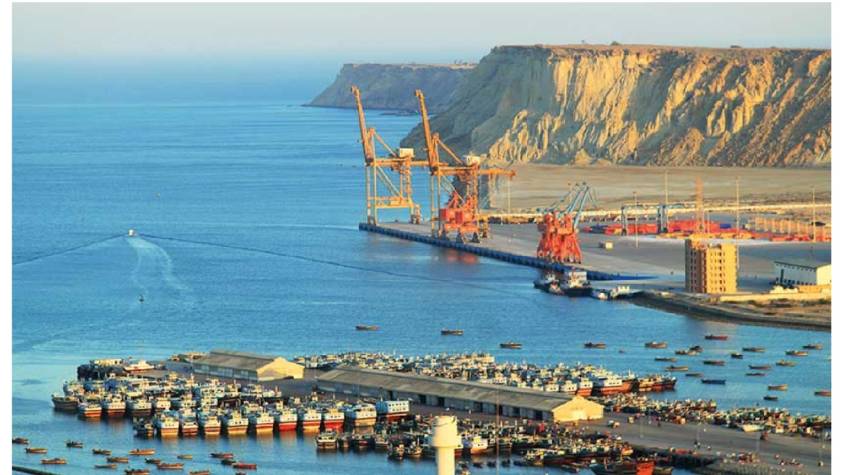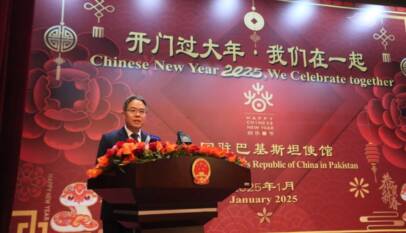Gwadar Port to enhance Pakistan’s geo-strategic position
Dr. Jamil Khan, Executive Director of Pak-Sino Enterprise writes that the Gwadar Port is a golden opportunity for Pakistan to transform itself into a prosperous economy. He said CPEC has made Gwadar the Crown Jewel of the BRI, making it the economic hub of the country as ports enhance quality of life, improve standards of living, and bring prosperity to their residents and neighbours. He also highlights that the Gwadar Port will become a strategic asset of the country by providing continued safe passage for trade and shipping. He uses the example of Singapore which gained independence in 1965 and rapidly developed as a modern economy due to its well-established ports, which are one of the busiest in the world. He also writes that Shenzhen Port located in southern part of China’s Guangdong Province is another very vibrant port that has transformed the local economy. He uses statistics from the regional study to highlight how Gwadar Port and CPEC maritime ecosystem will open new venues for robust exports and imports. He also adds that trading through the GP gateway will reduce about 3,000-kilometer distance to North East Asia, which will enhance Pakistan’s geo-strategic position.
The Gwadar Port (GP) is the golden opportunity for Pakistan to transform itself into a prosperous nation of the region through the path of robust economic growth, creation of higher paying jobs, and making it a permanent source for the desperately needed foreign exchange! Under the CPEC, the GP has been identified as its “Flagship” project and the “Crown Jewel” of the BRI. Thus, this will be a springboard for Pakistan to leapfrogging its progress and for achieving prosperity, just like the ports of Singapore and Shenzhen have contributed to their respective nations, Singapore, and China. In both cases, the ports contribute significant amounts to the local economies through creation of higher paying jobs. Moreover, ports enhance quality of life, improve standards of living, and bring prosperity to their residents and the neighbours. More importantly, ports become permanent GDP sources for their nations.
Nevertheless, the success of the GP (the only deep-water port of the region) lies in its fully functional maritime ecosystem and highlighting its advantages of the maritime distance reduction and the transportation costs savings to the major GCC members (Saudi Arabia, Oman and Iran) and the European countries who collectively conduct more than US$500 billion trade with the NE& SE Asia. Similarly, passing the trade through the GP gateway will help these BRI partners in reducing the maritime distance by about 3,000 kilometers, thus improving the supply chain. Additionally, this new gateway (GP) will not only bring the windfall of the cost savings to the users, but in case of any threat or hostility through the Straits of Malacca, the GP will be the most strategic route for the continued safe passage of the trade and shipping.
As a matter of fact, Pakistan aspired developing the Gwadar port (GP) in 1954, even when it was still under the rule of Sultanate of Oman. This dream was further strengthened when the United States Geological Survey (USGS) confirmed its suitability for developing it as a deep-water seaport. In September 1958, Sultanate of Oman handed over the GP to Pakistan as a goodwill gift. However, due to political instability and lack of funding, its development did not happen until 2001 when it was revived. Finally, in 2003 its construction was started and by 2007 its completion was inaugurated by then President Pervez Musharraf.
To realize the full potential of the GP and its impact on Pakistan’s economy, the policy makers and port’s management should adopt the blueprints from the ports of Singapore and Shenzhen (China), they both share the similar history.
Since Singapore’s full independence in 1965, it had to compete with other well-established ports in the region (like Hong Kong & Shanghai) for attracting international trade, commerce, and containers transloading. By developing a seamless export ecosystem (tax free zones, local & national subsidies for manufacturing, reduced energy costs, investment protection, fast track approvals, ease of doing business, reinvestment incentives, etc.) based on value-added manufacturing, the port has been transformed into a vibrant source of revenues. It obtains raw or partially manufactured products from regional and global markets and after finishing them, re-exports them back as the value-added products through the WTO’s market access directives and bilateral free trade agreements. Today, Singapore port is the busiest port for the transshipments in the world and the second busiest port after Shanghai in terms of the shipping tonnage.
According to Singapore Port Authority (PSA), every single day, 91,000 containers TEUs (Twenty feet Equivalent Unit) and 60 ships are moved through the port. Usually, about 6% of the containers are for the domestic destinations (for value additions) while the remaining are for transloading for the other destinations around the world. Since Singapore has no natural resources, everything is imported for its six million citizens for their everyday use. The entire port operation is fully automated. Thus, as the ships arrive in Singapore port vicinity, the captain is informed which dock to use. Remotely, containers are moved around from ships to the trucks, and to the onsite warehouses. The entire operation is controlled seamlessly from remote control centers. This is giving PSA the competitive advantage over other stablished ports, like ports of Hong Kong and Shanghai. The complete automation not only saves times but also gives cost savings and helping in reducing carbon footprint by keeping the ships at the port for as little time as possible. These competitive advantages have made the PSA one of the most efficient, competitive, and cost-effective ports in the world. On a yearly basis, the PSA handles so many containers that if they’re lined up can encircle the globe five times. Like Singapore port, GP is also located at the crossroads of the East-West, and North-South, thus can offer competitive advantages to its users and this fact should be leveraged to promoting it by the CPEC, BRI and more importantly by Pakistani foreign outposts (diplomats) around the globe through presentations, discussions, and hosting seminars to the steamship lines, freight brokers, exporters, and the multinationals.
Similarly, port of Shenzhen (PS) located in the southern part of China in Guangdong Province (close to Hong Kong) is another very vibrant port of the region and ranks third among the largest container ports in the world. The port was transformed from a little fishing harbor into a maritime port in 1980 with a total investment of less than US$10bn. Since then, it has gone through many capacity increases. Currently, its transshipment capacity is about 195 million tons, connecting it over 300 ports in more than 100 countries. Since the city of Shenzhen is the center of technology and is called the Silicon Valley of China, adaption of the cutting-edge technology of AI & ML in its 24/7 operations plays a very important role in syncing its entire ecosystem for the best service to its maritime clients. According to some estimates, in 2019 more than 30 million TEUs passed through the port.
Recent market studies show that the containerized trade and commerce is growing at an unprecedented rate throughout the world. According to some estimates, there will be 60-70% increase in the maritime transportation trade through the use of the containerships. With the recent renewed interest for the globalization and connectivity through the multilateral agreements (TPP, RCEP, CPEC, BRI, etc.), there is a beginning of a new phase of the industrialization. During the initial phase of the industrialization, the advanced countries were importing the raw materials from the developing/underdeveloped nations for manufacturing the consumer goods. However, with the continued momentum of the globalization, supported by the multinational corporations, new factories are being built at the sources of the raw materials, thus literally eliminating one leg of the manufacturing and delivery cycle from start to finish and from the cost structure.
According to the latest global trade statistics, in 2019 (prior to the Covid) global trade reached an all-time high of about $19 trillion and is projected to grow at an average rate of 10% during the next decade. Out of this, global containerized segment trade for the same period was about $13.5 billion. It is said that currently 80% of the global trade by volume and greater than 70% by value is carried out through the maritime. This means that with the continued increase in the global trade, there will be more need of the megaships/Panamax vessels to transport large volumes of the commodities from one region to the other. Currently, there are about 180 megaships that can carry more than 15,000 TEUs per ship. There are at least 47 ultra-large ships that can carry 25,000 and higher number of the TEUs. It is projected that with this continued trend, by 2025, up to 90% of the global trade will be carried out by the maritime vessels. However, currently most of the container ports are not ready to handle these megaships, as they are not deep enough, nor do they have the infrastructure and the equipment to handle the flood of the containers on their docks. In other words, the megaships require deep water ports to accommodate their sheer sizes and weights for loading and unloading of the containerized goods on the dock sides.
According to a regional study, the GP and its CPEC maritime ecosystem will open new venues for robust exports and imports, stretching all the way from the ME to Asia, Europe and reaching all the way to Africa. This robust trade and commerce activities will be happening at an unprecedented rate due to the significant cost savings and the transit time reductions. The GP will be giving a competitive cost advantage dividends not only to Pakistan and China but also to the Central Asian nations and everyone who will be using this strategic gateway (GP) for their global trade & commerce expansions and for making their economies resilient and thriving in the coming years.
Since the GP is a deep-water seaport, trade flowing through this gateway and its ecosystem, total logistics costs and the transit times to NE Asia will be reduced significantly. An in-depth study carried out in 2018-2019 (trade through Shanghai port) shows that trading through the GP gateway will bring significant cost savings not only to its Quad members but also to the other BRI partners. According to the study, Saudi Arabia on the average is spending $23.7 billion on its imports while exporting $26.4 billion of the commodities outside Saudi Arabia. This makes a total trade value of $50.1 billion. By using the GP and the BRI infrastructure network, Saudi Arabia will achieve a combined cost savings of $7.5 billion, resulting from the shipping cost reductions and time savings. Similarly, Oman’s combined trade value during the same period was of $13.7 billion and by using the GP and its network, it will gain a total savings of $2.05 billion. Beyond the ME, European countries will also benefit significantly by trading through this strategic gateway! For example, Germany, the major exporting country of the EU, was doing $202.8 billion trade during the same period but by going through the GP/BRI network, it will enjoy a total savings of $30.42 billion. Similarly, France, another major trading country of the region with a total trading value of $73.6 billion, will benefit with more than $11 billion savings. The third biggest trading EU country, the Netherlands, did about $73.5 billion of the trading during the same period will pocket savings of more than $11 billion as well.
These studies clearly show that how pivotal Gwadar port will be in the trading not only for the ME and Europe, but also to and from the African region. Trading through the GP gateway will reduce about 3000-kilometer distance to NE-Asia compared to the current maritime voyage of 12,000 kilometers through the Straits of Malacca.
This new gateway (GP) will not only bring cost savings to the users but in case of any threat or hostility through the Straits of Malacca, the GP will be proven as the most strategic route for the continued safe passage of the trade and commerce for all the nations who have vested interest in the BRI.
Chinese Ambassador highlights significance of Third Plenary Session for China-Pakistan cooperation
The Third Plenary Session of the 20th Central Committee of the Communist Party of China ha…












